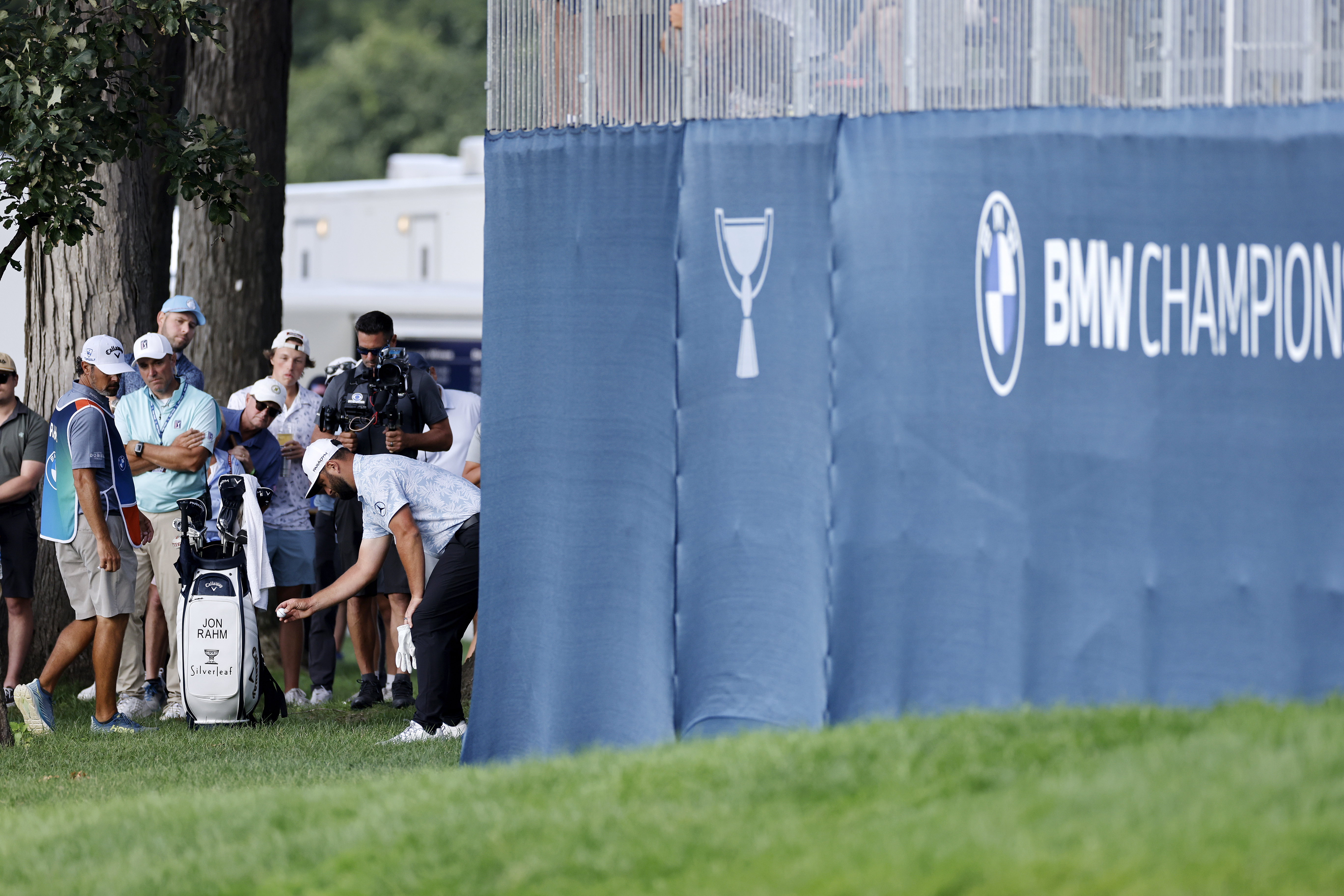As an Amazon Associate GolferHive.com earns from qualifying purchases.
TIO in Golf: The Rule Explained With Examples
Ever watched a PGA Tour event and seen a player get a free drop away from a massive grandstand, leaving you wondering how that’s possible? You’re not alone. The rules surrounding these temporary structures can seem confusing, especially when they appear to give professional golfers a huge advantage that amateurs don’t get. This guide will demystify one of the most talked-about rulings in golf.
TIO in golf stands for Temporary Immovable Obstruction. It is a non-permanent, artificial structure like a grandstand, hospitality tent, or TV tower that has been added to the course for a competition and is not readily movable.
Leveraging extensive analysis of official golf rules and high-profile tournament examples, this guide unpacks everything you need to know about the TIO rule. We’ll explore exactly what qualifies as a TIO, the two types of interference that grant you relief, the precise step-by-step procedure for taking that relief, and dive into the controversial rulings that have sparked debate among golf fans worldwide.
Key Facts
- Unique Relief: The defining feature of a TIO is that it offers relief for line-of-sight interference, a benefit not typically granted for permanent obstructions on the course.
- Official Governance: Relief from a TIO isn’t an informal agreement; it’s governed by a specific rule, Model Local Rule F-23, which committees can adopt for competitions.
- Not Part of the Challenge: The logic behind the TIO rule, as noted by sources like Golf Monthly, is that these structures are not considered part of the inherent challenge of playing the course.
- Pro Tour Staple: Due to extensive infrastructure, TIOs are a common sight at professional events, leading to famous rulings involving players like Matt Kuchar and Jon Rahm that have been widely debated.
- “Virtually Certain” Clause: A key aspect of the rule allows for relief even if a ball is not found, as long as it is “virtually certain” (meaning 95% or greater certainty) that it came to rest inside the TIO.
What is a TIO in Golf? The Official Rule Explained
TIO in golf stands for Temporary Immovable Obstruction. It is a non-permanent, artificial structure like a grandstand or TV tower added to the course for a competition that is not readily movable. This definition, based on official golf rules such as Model Local Rule F-23, forms the foundation for understanding one of the game’s most interesting situations.

These objects are considered “temporary” because they are not permanent features of the course design; they’re brought in specifically for an event. They are “immovable” because they can’t be moved without unreasonable effort or causing damage. The Committee in charge of the competition is responsible for officially designating these structures as TIOs.
Quick Fact: Ever wondered about those giant tents at a PGA Tour event? You’re looking at a TIO!
Common examples of objects that are often classified as a TIO include:
* Grandstands or bleachers
* Hospitality tents and marquees
* Large, temporary scoreboards
* Television towers and camera platforms
* On-course lavatories or portable toilets
* Staging areas for tournament equipment
The key takeaway is that these structures aren’t meant to be part of the strategic challenge of a golf hole. The rules provide a way to get relief from them because they are artificial additions for the purpose of running a tournament.
Understanding Interference from a TIO: When Can You Get Relief?
You can get relief from a TIO if it causes either physical interference (touching your ball, stance, or swing) or line-of-sight interference (blocking the direct line between your ball and the hole). Understanding these two conditions is crucial to knowing your rights on the course when a TIO is in play.
So, a grandstand is blocking your perfect shot to the green? Unlike a tree, the rules might just be on your side. Let’s break down the two types of interference.
- Physical Interference: This is the most straightforward type of interference. It occurs when your ball is physically touching or inside the TIO, or when the TIO gets in the way of your intended area of stance or swing. For example, if your ball rolls to a stop under a grandstand, or if you have to stand on a temporary TV tower platform to make your swing, you have physical interference.
-
Line-of-Sight Interference: This is what makes the TIO rule so unique and powerful. As confirmed by sources like Golf Digest, this type of relief is generally not available for permanent immovable obstructions. Line-of-sight interference exists when the TIO is on the direct line between your ball and the hole.
The rule provides for a “corridor” of relief. This means interference exists if the TIO is on the straight line to the hole or within a one club-length arc on either side. This extra space ensures that when you take relief, the TIO is completely out of your line of play for the shot you intended to hit.
This provision prevents a player from being unfairly penalized by a structure that was never meant to be part of the course’s design. It’s the reason you see PGA Tour players get drops that sometimes move them into a much more favorable position.


How to Take Free Relief from a TIO (Model Local Rule F-23)
To take free relief from a TIO, you must find the nearest point of complete relief (from both physical and line-of-sight interference) and drop your ball within a one club-length relief area, no nearer the hole. This procedure is governed by Model Local Rule F-23, ensuring a standardized process for all players.
Taking relief correctly is essential to avoid a penalty. Here is the step-by-step process for getting your ball back in play without interference from a TIO.
- Identify the Point of Interference: First, confirm that you have either physical or line-of-sight interference from the TIO.
- Find the Nearest Point of Complete Relief (NPCR): This is the most critical step. The NPCR is the spot on the course, nearest to where your ball currently lies, where the TIO no longer causes any interference (neither physical nor line-of-sight). This point cannot be nearer the hole. You find this point by simulating the stance and swing you would make for your shot.
- Establish Your Relief Area: Once you’ve identified the NPCR, you measure one club-length (using the longest club in your bag, other than your putter) from that point, no nearer the hole. This creates a semi-circle relief area.
- Drop the Ball: You must drop your ball from knee height so that it lands and comes to rest within this relief area. If you drop incorrectly or the ball rolls outside the area, you must re-drop.
Pro Tip: Remember, the goal is complete relief. If your foot is still on the edge of the TIO’s footprint after you drop, you haven’t taken relief correctly!
The procedure can vary slightly depending on where your ball is located on the course:
* General Area: If your ball is in the general area (the main part of the course), your NPCR and your relief area must also be in the general area.
* Bunker or Penalty Area: If your ball lies in a bunker or penalty area, you must first try to take complete relief inside that same bunker or penalty area. If complete relief inside is impossible, you can find the point of maximum available relief inside that area. Alternatively, you can take relief outside the bunker or penalty area, but this comes with a one-stroke penalty.
TIO vs. Other Obstructions: A Clear Comparison
Unlike permanent Immovable Obstructions (e.g., cart paths), Temporary Immovable Obstructions (TIOs) are unique because they offer relief for line-of-sight interference, not just physical interference. This distinction is the most common point of confusion for golfers, but a clear comparison makes the rules easy to understand.
The Rules of Golf have several classifications for artificial objects you might encounter. Knowing the difference is key to playing by the book. Based on definitions from authoritative sources like GolfMagic and Mass Golf, here is how they stack up.
| Obstruction Type | Example | Can it be Moved? | Free Relief Available? | Line-of-Sight Relief? |
|---|---|---|---|---|
| Movable Obstruction | Rake, water bottle, towel | Yes | Yes (by moving the object) | Not Applicable |
| Immovable Obstruction | Cart path, sprinkler head, building | No | Yes (for physical interference only) | No |
| Temporary Immovable Obstruction (TIO) | Grandstand, TV tower, tent | No | Yes (for physical & line-of-sight) | Yes |
| Integral Object | Gates, stone walls inside hazards (if declared by Committee) | No | No | No |
| Boundary Object | White stakes, fences defining out-of-bounds | No | No | No |
As the table clearly shows, the special provision for line-of-sight relief is what sets a what is tio golf situation apart from dealing with a sprinkler head or a cart path. While you can get a free drop if a cart path interferes with your stance or swing, you can’t claim relief just because it’s between your ball and the hole. With a TIO, you can.
Famous (and Controversial) TIO Rulings on the PGA Tour
High-profile TIO rulings, like Matt Kuchar’s controversial drop at the Wyndham Championship, highlight how the rule, while legal, can lead to significant advantages and debate among golf fans. These real-world examples show just how impactful understanding the TIO rule can be at the highest level of the sport.
Rhetorical Question: After seeing how the pros use the TIO rule, do you think it provides an unfair advantage? It’s a hot debate in the golf world.
- Matt Kuchar: Perhaps the most famous TIO incident in recent memory. At the Wyndham Championship, Kuchar needed to save par on his final hole to secure his PGA Tour card. His tee shot went wayward, but a large scoreboard (a TIO) was on his line of play. He returned the next morning to finish the hole, got TIO relief, and was able to drop his ball in an adjacent fairway, giving him a clear shot. He saved par, but the ruling, highlighted by GolfMagic, sparked intense debate.
Fans questioned the fairness, arguing it provided an escape from a terrible shot that amateur golfers would never get.
- Sergio Garcia: At the 2017 BMW Championship, Garcia received free relief from a grandstand even though his ball was technically in a lateral water hazard. As explained by sources from the US Open, because the TIO interfered with his line of play from the hazard, he was entitled to relief, a ruling that surprised many viewers.
-
Jon Rahm: During the 2025 Genesis Invitational, Rahm’s drive ended up in an area used for staging tournament equipment. This area was designated as a TIO, and he received a free drop. As reported by EssentiallySports, fans were again furious, feeling it was an overly generous drop that bailed him out of trouble.
-
Jordan Spieth: At the Valero Texas Open, Spieth found himself behind a building. Knowing it was not out of bounds, he intentionally hit his ball onto the property, then pointed out that a scoreboard (a TIO) was now on his line of sight to the green. He was granted relief from the TIO, giving him a much clearer path for his next shot.
-
Carl Yuan: At the Sony Open, Yuan’s ball was lost after heading towards a grandstand. Without definitive proof of where it ended up, rules officials determined it was “virtually certain” the ball was lost inside the TIO. As analyzed by The Fried Egg, this ruling allowed him to take free relief instead of a penalty for a lost ball, demonstrating the power of the “virtually certain” clause.
These moments underscore that while the TIO rule is applied correctly by officials, its outcomes can feel inequitable and often lead to dramatic moments on tour.
To navigate the course and its rules like a pro, having the right reference materials and tools can make all the difference. Equip yourself with the essentials to confidently handle any situation, from a simple drop to a complex TIO ruling.
FAQs About TIOs in Golf
Here are answers to some of the most frequently asked questions about Temporary Immovable Obstructions.
What is the difference between a TIO and a regular Immovable Obstruction?
The key difference is that a TIO offers relief for line-of-sight interference, while a regular Immovable Obstruction (like a cart path or a permanently installed electrical box) typically does not. For a standard immovable obstruction, you only get free relief if it physically interferes with your ball, your stance, or your area of intended swing.
Do you get free relief from an electrical box on the course?
Yes, you get free relief from an electrical box if it interferes with your ball, stance, or swing, but not just because it’s on your line of play, as it is a permanent Immovable Obstruction, not a TIO. You would follow the standard procedure for relief from an immovable obstruction, which does not include the line-of-sight provision.
Can a committee deny TIO relief?
Yes, a rules official can deny TIO relief if a player is clearly using an unreasonable stance or stroke simply to take advantage of the rule. For instance, if you aim 30 yards right of the green just to bring a TIO into your line of play, an official can deny the relief. This prevents players from “gaming the system,” a point clarified in analysis from sources like Golf Digest.
What does “virtually certain” mean for a ball lost in a TIO?
“Virtually certain” means there is conclusive evidence (95% or greater certainty) that the ball is lost within the TIO, even without seeing it, allowing the player to take relief. This requires strong evidence, such as multiple people tracking the ball’s flight directly into a grandstand. The Carl Yuan incident at the Sony Open, reported by The Fried Egg, is a prime example of this rule in action.
No, TGL (Tomorrow’s Golf League) is a technology-focused golf league and is completely unrelated to TIO (Temporary Immovable Obstruction), which is a term from the Rules of Golf. TGL is a venture founded by Tiger Woods and Rory McIlroy, while TIO is a classification for objects on a course during a competition. The similar acronyms are purely coincidental.
Final Summary: Mastering the TIO Rule
Understanding what is tio in golf transforms you from a casual observer into a knowledgeable player who can appreciate the nuances of the game at its highest levels. It’s more than just a rule; it’s a principle that acknowledges certain objects are not part of a course’s intended challenge. By learning its intricacies—from the crucial distinction of line-of-sight relief to the step-by-step dropping procedure and the real-world dramas it creates on the PGA Tour—you gain a deeper insight into the strategic decisions players make under pressure.
This guide has provided a complete picture, from the official definition to the controversies. Let’s recap the most critical points:
- Definition: A TIO is a temporary, non-permanent structure like a grandstand or tent that offers relief from both physical and line-of-sight interference.
- Key Advantage: The unique allowance for line-of-sight relief is what separates TIOs from all other permanent obstructions on the course.
- Proper Procedure: Relief involves finding the nearest point of complete relief (NPCR) and dropping within one club-length, no nearer the hole, as governed by Model Local Rule F-23.
Now that you’re an expert on TIOs, keep an eye out for them during the next pro tournament—you’ll see the game in a whole new light
Last update on 2025-12-06 / Affiliate links / Images from Amazon Product Advertising API

